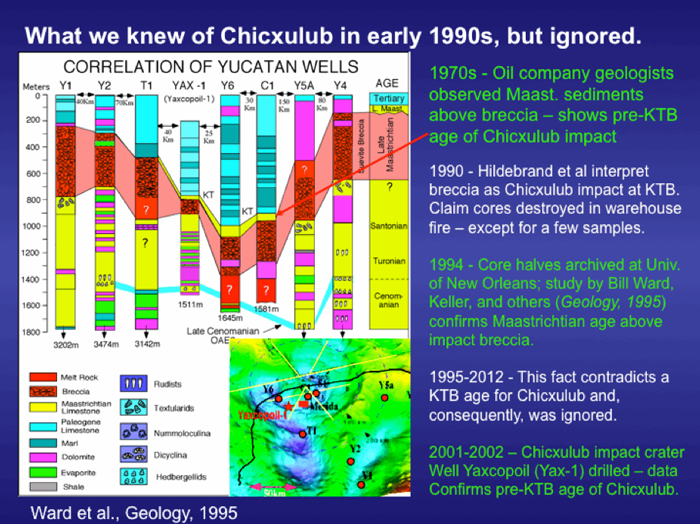
Figure 20. Correlation of Yucatan wells modified from Ward et al. (1995). YAX-1 is the new core Yaxcopoil-1 drilled in 2000-2001 that sparked renewed controversy (Keller et al., 2004, 2005).
To show once and for all that the Chicxulub impact caused the KTB mass extinction
The 2001-2002 drilling of the Chicxulub crater core Yaxcopoil-1 by DOSECC (Drilling, Observations and Sampling of the Earth’s Continental Crust) was supposed to resolve the age issue and show once and for all that Chicxulub is the KTB impact that caused the mass extinction (Dressler et al., 2003). Instead, the new crater core supported the previous findings of a pre-KTB age and fueled a new controversy.
One of the major objectives of this project was to settle the controversial issue of the age of the impact breccia and hence the age of the Chicxulub impact. A site on the Hacienda Yaxcopoil was chosen. The site was believed to be in the center of the crater and drilling was expected to recover the impact melt sheet and thick breccia deposits (Fig. 17). This was not the case. No melt sheet was recovered and the breccia was only 100 m thick, significantly less than the 300-600 m recovered by PEMEX. This suggests that drilling occurred near the crater rim on uplifted fault blocks (Fig. 20).
Yaxcopoil-1 drilled to a depth of 1511m within the Chicxulub crater. An organic-rich marly limestone near the base of the hole (1495m to 1452m) was deposited in an open marine shelf environment during the latest Cenomanian (top of Rotalipora cushmani zone). The overlying sequence consists of limestones, dolomites and anhydrites (1495m to 894m) and indicates deposition in various carbonate platform environments (e.g., sabkhas, lagoons). A 100m thick suevite breccia (894-794m) identifies the Chicxulub impact event. Above the suevite breccia is a dolomitized micritic limestone followed by laminated limestones and thin glauconitic clay layers. The KT boundary is 50 cm above the suevite breccia (Figs. 21a and 21b).

Figure 21a. Core Yaxopoil-1 shows the uppermost part of the suevite breccia and the lower 20 cm of the overlying dolomitized, laminated micritic limestone. Note that the upper 15 cm of the brecia are reworked and current. Melt glass is reported from this interval.
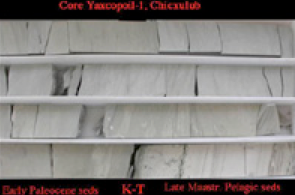
Figure 21b. Core Yaxcopoil-1: the bottom core length shows the KT boundary green clay and the underlying 30 cm with several glauconitic green clay layers.
Sampling Party and The Vanishing Core - Redux
In the spring of 2002 a select group of scientists from both sides of the impact controversy met at the University of Mexico (UNAM) to examine the Yaxcopoil-1 cores and submit a list of the sample intervals they wish to study. The sampling would be done by a team at UNAM and distributed by summer. Results would be presented in a session on the Chicxulub Drilling at the combined AGU-EGU Conference in Niece, France, in the Spring of 2003.
The core with the top of the breccia and the overlying 50 cm limestone followed by the KT boundary held the most interest. By the end of the day, that core was missing – seemingly vanished. It was reminiscent of an earlier drilling of the impact crater by UNAM (core UNAM-5) that also recovered the KTB and impact breccia. But the critical core between those events vanished and never resurfaced. Consequently, no studies were ever published – including ours although we completed a wealth of analyses while waiting for samples of the vanished core interval. However, without that interval no conclusions could be reached concerning the KTB and the impact.
On that fateful spring day at UNAM in Mexico City history seemed to repeat itself among a group of scientists. What was there to hide in a core of sediments above the impact breccia? A frantic search for the core began and miraculously the core was found – in the duffel bag of Jan Smit. He took it for safekeeping he said and for sampling. He claimed he was entitled to it and authorized to take the core – though no authorization was given or discussed at the meeting.
By the end of 2002 scientists who questioned the Chicxulub impact hypothesis, or were not in the small in-group surrounding the drilling crew, had not received any samples despite many inquiries. Abstracts for the AGU-EGU conference in Niece were due in January. Keller’s persistent questioning of the whereabouts of the samples and who controlled the distribution of the critical core interval above the impact breccia lead the trail to Jan Smit. After many calls and discussions with Jan Smit, Keller received samples at the end December. It turned out that nobody else in the out-group received samples.
Each sample was very small ranging from 0.5 to 1.0 cm3. A very small amount for the paleontologic, sedimentary and geochemical analyses required for out study. Plus there was little time for the analyses as the abstract deadline was in less than three weeks. Our team members were located at the University of Karlsruhe, University of Neuchatel and Princeton University. We shared the small samples. The team worked frantically day and night, shared samples were shipped overnight, and daily consultation followed. The first task was thin sections of each sample for paleontological analysis, then the geochemiscal, sedimentologic and mineralogic analyses followed (XRD, ESEM, isoluble residues, and microfossils). An abstract was submitted with the preliminary results – Chicxulub predates the KTB in the new Yaxcopoil-1 core.
Yaxcopoil-1: Chicxulub Impact Predates KTB
At the AGU-EGU conference the largest lecture hall was reserved for the unveiling of the Chicxulub drilling results. The drilling team had already announced in EOS that the Impact hypothesis was proven at Chicxulub – the impact caused the KTB mass extinction (Dressler et al., 2003). The Chicxulub Drilling results session was scheduled for the first day beginning at 8 am.
The 2003 meeting at Niece was plagued by delays due to high security checks for attendants and the fact that there was only a single screening device for 10,000 people. Kilometer long lines with hours waiting to access the conference hall made it all but impossible to begin the meeting at 8am. Access was permitted ahead of the line only for those who had to lecture in the early morning – largely to rooms of empty chairs. The giant lecture hall for the Chicxulub presentations was nearly empty. Perhaps two dozen scientists and journalists had made it for the unveiling at 8 am. They were not disappointed.
The first speaker was Jan Smit who proclaimed that all is as predicted, Chicxulub hit Yucatan precisely at the KTB and caused the mass extinction. He explained the 50cm limestone between the impact breccia and the KTB as backwash and crater infill with the thin green layers altered impact glass. Keller was next and began by saying “you will now hear the opposite based on exactly the same samples – the Chicxulub impact predates the KTB mass extinction”. Pandemonium broke out with some scientists shouting obscenities – it was not a gentlemanly audience. Here is the evidence presented at that AGU-EGU meeting that sparked a renewed and fierce controversy.
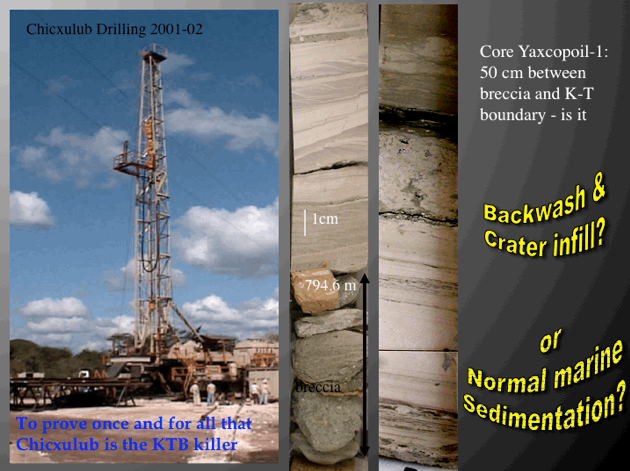
Figure 22. Drilling of the Chicxulub crater in 2000-2001 revealed the KTB 50 cm above the impact breccia. The argument now centered over the interpretation of this 50 cm interval. Was it backwash and crater infill? Or normal marine sedimentation? Keller et al., 2004, 2005.
Backwash and Crater Infill to the Rescue
The 50 cm thick laminated, partially dolomitized, micritic limestone that unconformably overlies the suevite breccia and underlies the KT boundary holds the key to determining the age of the Chicxulub impact and the nature of the post-impact paleoenvironment (Fig. 22). In order to have a common origin for the suevite breccia and the KT boundary, this 50 cm layer must be interpreted as part of the impact event, such as backwash and crater infill, as commonly argued (Smit et al., 2004, Arz et al., 2004; Dressler et al., 2003). In support of this interpretation, it is claimed that this 50cm interval shows high-energy activity in the form of cross bedding and grain size grading, abundant impact melt rock now altered to green clay layers and quartz minerals.
Backwash and crater infill is expected to erode, transport and redeposit material from the surrounding crater walls via slumps or gravity flows due to earthquakes or unstable topography, and by currents. The argument goes that Gulf of Mexico waters rushed in through a 100km wide and 1km deep trough, sliced off by the impact in the northern part of the crater, transporting a mix of reworked sediments and faunas and depositing them in the crater. This scenario can be evaluated based on the sediments overlying the Chicxulub breccia. To validate the backwash and crater infill scenario the sediments must contain:
- Sedimentary structures indicative of high-energy currents (e.g. cross-bedding, flaser bedding, grain size grading.
- Highly variable lithoclasts from the diverse underlying strata, such as shallow water limestones, gypsum, dolomite, anhydrite, and breccia clasts.
- A significant amount of melt rock either as glass fragments or glass altered
- Reworked microfossils and macrofossils faunas from the underlying sediments, such as shallow water benthic foraminifera and invertebrates that are common in the lagoonal to subtidal Cretaceous environments of the Yucatan platform.
- Reworked fauna must show evidence of diverse ages reflecting the deep erosion and disturbance of underlying sediments.
Evidence Support Normal Sedimentation – Not Tsunami
- No evidence for cross-bedding and grain size grading:
The sediments of the 50 cm interval predominantly consist of laminated micritic limestone with patches or microlayers of dolomite. The micritic limestone is finely crystalline, whereas the dolomite crystals are large and angular. At first sight this may give the impression of grain size grading. However, dolomite formed by diagenetic replacement of the precursor (micritic) limestone with the laminated texture still visible. The micritic limestone indicates deposition in quiet water conditions.
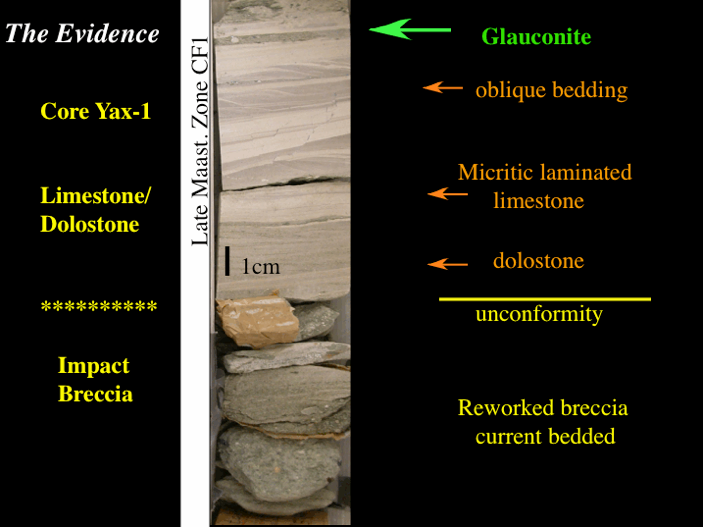
Figure 23. Core Yaxcopoil-1 showing the top of the impact breccia and overlying micritic limestone, oblique bedding and first glauconite layer. From Keller et al., 2004, 2005.
Core Yax-1 shows three <1 cm thick layers of oblique bedding within an 8 cm thick interval between 794.45 and 794.53 m that has been referred to as cross-bedding (Fig. 23). Cross-bedding must have grain size changes of at least medium to fine grained sand. We found no grain size changes and samples dissolved in acid show almost no insoluble residues and no quartz grains. We could not confirm Smit’s claim of common sand grains with dolomite overgrowth. If such sand grains were present, they should be in the insoluble residues. The apparent grain size change in these sediments is diagenetic due to dolomitization as evident in Fig. 24.
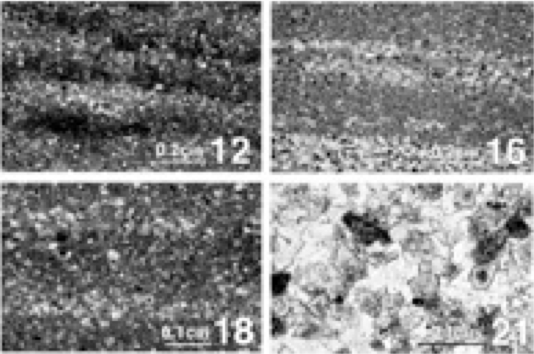
Figure 24. Limestone lithologies from Yaxcopoil-1. 12. Laminated microlayers in micritic limestone, 16. Laminated micritic limestone enhanced by partial dolomitization. 18. Laminated micritic limestone enhanced by early stage dolomitization. 21. Dolostone, advanced diagenetic alteration of the original micritic limestone and replacement by angular dolomite crystals.
Grain size change is also characteristic of flaser bedding. Based on visual examination we thought there was flaser bedding, though insoluble residues revealed only some glauconite or glauconite coated microclasts. Burrowing structures account for the apparent mottled character of these intervals.
Our analyses could not confirm the presence of cross-bedding, flaser-bedding or grain size grading. Diagenetic growth of dolomite crystals, burrowing organism and glauconite formation appear to account for the features identied as evidence of high-energy current bedding.- Polymict clasts? Breccia? Melt Rock?
By visual core examination, we originally identified several very thin (<0.5 cm) microconglomerate layers as possibly supporting reworking and redeposition from the impact breccia. Closer examination revealed five thin green clayey microclast layers interbedded with the laminated micritic limestone (794.43, 794.34-35, 794.24, 794.19, 794.11)(Fig. 25). Insoluble residues revealed these microclasts to be of glauconitic origin or have in situ glauconite coating (see below). We observed only very rare clasts and very rare glass shards. These insignificant amounts argue against backwash and crater infill from reworked and transported material.
- Glauconite layers
Five green clay and glauconite layers, each strongly burrowed, are present at the KT boundary and in the 50 cm below (Fig. 25). Smit and others (2004) interpreted these glauconite layers abundant altered impact glass. No evidence was ever presented to substantiate this claim.
Impact glass alters to a characteristic, almost pure Cheto smectite (Keller et al., 2004). XRD and ESEM analyses indicate that Cheto smectite is present in the impact breccia (Fig. 25). However, the green clay at the KT boundary and in the other four intervals is of glauconitic origin and represents a mature glauconite (Fig. 25) (Keller et al., 2004, 2005).

Figure 25. Chicxulub core Yaxcopoil-1 showing the 50cm between the KT and impact breccia with five green glauconite layers. Each glauconite layer has the standard glauconite EDX spectra. XRD analysis shows that glauconite has a distinctly different signal from impact glass. From Keller et al., 2004, 2005.
Glauconite forms at the sediment-water interface in environments with very slow detrital accumulation as a result of sediment winnowing by gentle bottom currents and clast generation. The five green layers therefore indicate long pauses in the overall quiet depositional environment with slightly more active, though still minor current activity and small-scale transport. Each glauconite layer likely accumulated over at least 10,000 years. This means that the 50cm of limestone with the five glauconite layers likely accumulated over more than 50,000 years.
The five layers of glauconite thus effectively rule out a scenario of rapid deposition, high-energy currents, backwash and crater infill within days of the Chicxulub impact.
Age of Sediments Above Impact Breccia
The depositional age of the 50 cm thick laminated micritic limestones between the top of the suevite breccia and the KT boundary can be determined from the presence of planktic foraminifera. This critical interval contains diverse planktic foraminiferal assemblages characteristic of zone CF1, which spans the last 160 kyr of the Maastrichtian (KTB at 65.5 Ma (Fig. 26). These assemblages include Globotruncana stuarti, G. insignis, G. arca, G. falsocalcarata, Abathomphalus mayaroensis, Rosita contusa, R. petaloidea, R. walfishensis, Rugoglobigerina rugosa, R. macrocephala, Plummerita hantkeninoides, Globotruncanella petaloidea, Heterohelix, Hedbergella sp. and Globigerinelloides aspera. Small benthic foraminifera are also present (mostly buliminellids), but there are no reworked shallow water benthic foraminifera from below the breccia. No planktic foraminifera lived within the lagoonal to subtidal environment of the pre-impact Yucatan platform.
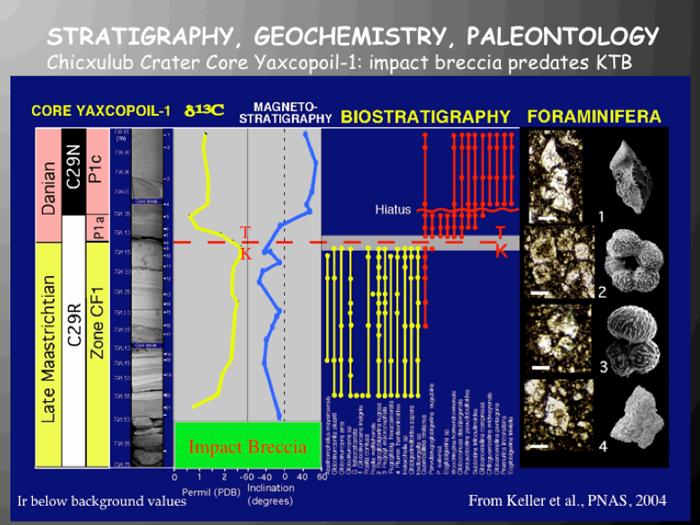
Figure 26. Biostratigraphy, carbon isotopes, magnetostratigraphy and planktic foraminifera of the 1 m interval above the Chicxulub impact breccia at Yaxcopoil-1. From Keller et al., 2004, 2005.
Additional age data comes from magnetostratigraphy. The KTB is always in magnetochron C29r. In the Chicxulub crater core the interval between the impact breccia and a short interval above the KTB is in C29r (Fig. 26). Moreover, the magneto signal is consistently low, which rules out chaotic sedimentation of different lithologies and ages. This is further independent evidence against the backwash and crater infill hypothesis of Smit et al., 2004).
More evidence of normal sedimentation is indicated by the carbon isotope data, which also show uniform Maastrichtian values below the KTB, except in the dolostone which is diagenetically altered and no longer contains the original signal. At the KTB the mass extinction is marked by the d13C shift as in all KTB sequences worldwide and followed by low values in the Danian. Planktic foraminiferal biostratigraphy is consistent with these other proxies showing the mass extinction and evolution of Danian species at the KTB (Fig. 26).
Thus, lithology, magnetostratigraphy, carbon isotopes, and planktic foraminiferal assemblages provide four independent proxies identifying the KTB after an interval of normal sedimentation after impact breccia deposition. Based on planktic foraminiferal assemblages and the presence of the index specie P. hantkeninoides the Chicxulub impact crashed into Yucatan sometime during the last 160 ky of the Maastrichtian, similar to the age of spherule deposition in NE Mexico. (Note that the old time scale with the KTB at 65.0Ma was used in publications prior to 2011)
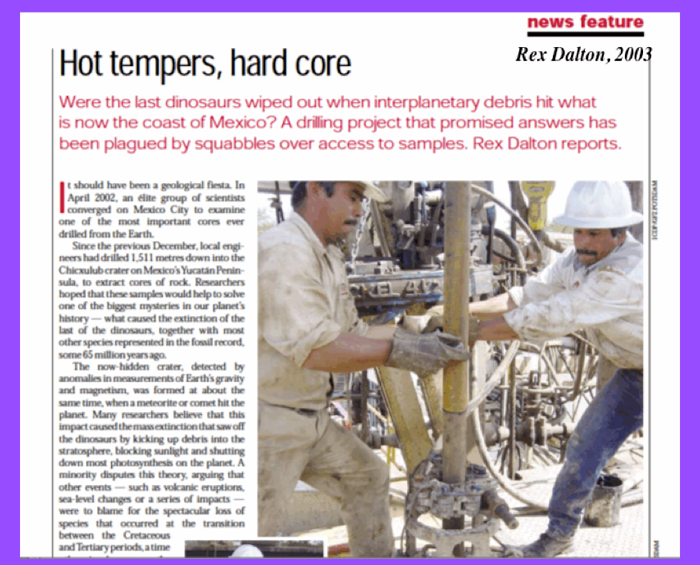
Figure 27. Article on the Chicxulub controversy by Rex Dalton appeared in Nature 2003.
What Critics Say
The new Yaxcopoil-1 results met with fierce criticism from impact proponents and wide publicity. The controversy resulted in the 2004 BBC Horizon documentary What killed the Dinosaurs. It was not the lack of data supporting the impact-kill hypothesis that was criticized, but rather the data that was produced but that didn’t support it.
Smit et al. (2004) interpreted the 50-cm-thick limestone as tsunami backwash and crater infill following the impact based on little data and a continued strong belief in the impact-tsunami hypothesis. Just as in NE Mexico, the stratigraphic separation between the impact evidence and the KTB had to be explained away as instant deposition – in this case tsunami backwash and crater infill.
6.4.1. Foraminifera and dolomite crystals
In this interpretation the presence of planktic foraminifera of latest Maastrichtian zone CF1 age in the 50cm thick limestone were of particular concern because this presence indicates normal marine sedimentation. From the time of my presentation at the Niece AGU-EGU meeting to the present Smit has claimed that foraminifera do not exist in these sediments and the forms illustrated are nothing but dolomite crystals. He has maintained this view despite corroborating findings of planktic foraminifera in the same samples by his collaborator (Arz et al., 2004) and subsequently by Michelle Caron, whom he had asked to evaluate the samples.
Both Arz and Caron noted that in addition to the late Maastrichtian assemblage there are also some reworked earlier Cretaceous species present, which should be expected due to erosion of the crater walls. To this day (Geological Society of America (GSA), Annual Meeting 2009, Portland, and European Geophysical Union (EGU) meeting 2010) Jan Smit maintains that the 50-cm-thick limestone marks tsunami backwash and that no planktic foraminifera are present.
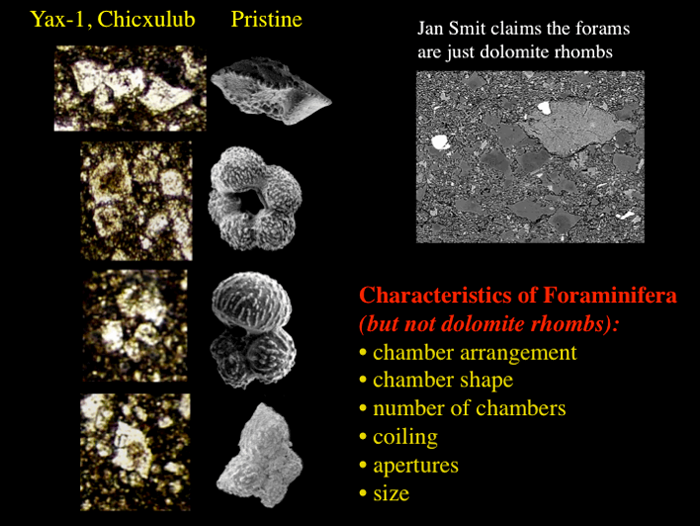
Figure 28. Planktic foraminifera in thin sections from the 50cm limestone between the impact breccia and the KTB, along with 3D images of the same species. Smit maintains to this day that there are no foraminifera in this core and that the images illustrated are just dolomite crystals even though the presence of foraminifera was confirmed by other experts. From Keller et al., 2005.
In contrast, Schulte et al. (2010) argued that all foraminifera are reworked and that their presence and grain size data (of crystals) in the 50-cm-thick limestone of Yaxcopoil-1 indicate erosion and reworking rather than long-term deposition. However, neither the presence of rare reworked foraminifera nor grain-size data (which reflects the dolomitization of the limestone) have any bearing on either long-term or short-term deposition.
More telling is the evidence Schulte et al. (2010) ignore of the multi-proxy evidence for long-term deposition in the Yaxcopoil-1 crater core, particularly the presence of five glauconite layers, each of which took at least 10,000 years to accumulate, the bioturbation that reveals that it cannot be backwash and crater infill, the late Maastrichtian carbon isotope values, and deposition in chron C29r below the KTB, none of which can be accounted for by chaotic instantaneous deposition after the impact (Keller et al., 2004a).
Schulte et al. (2010, p. 1216) argue for a KTB age based on three points: (1) (unspecified) geochronologic data that correlates the KTB with the Chicxulub impact (note that to date there is no geochronologic data on the Chicxulub impact that is more accurate than within 600,000 years (1% error for K/Ar and Ar/Ar dating); (2) no other large impact besides Chicxulub occurred during the last million years of the Cretaceous, and (3) ‘orbital cycles in deep-sea sites demonstrate that there is neither a 300,000 years gap nor hiatus between the Chicxulub impact and the KT boundary’.
These arguments are puzzling in that they ignore the Chicxulub data in favor of presenting rather weak, insufficient, unspecified and untested information to support their conclusion of a KTB age and retain the impact hypothesis.
Under any normal circumstances the extremely strong multi-proxy evidence together with the latest Maastrichtian index species (Plummerita hantkeninoides, zone CF1) would be considered unquestionably long-term deposition during the latest Maastrichtian. But these are not normal circumstances. The validity of the KTB impact theory necessitates that Chicxulub is KTB in age. Exuberant beliefs lead to irrational interpretations no matter what the evidence.
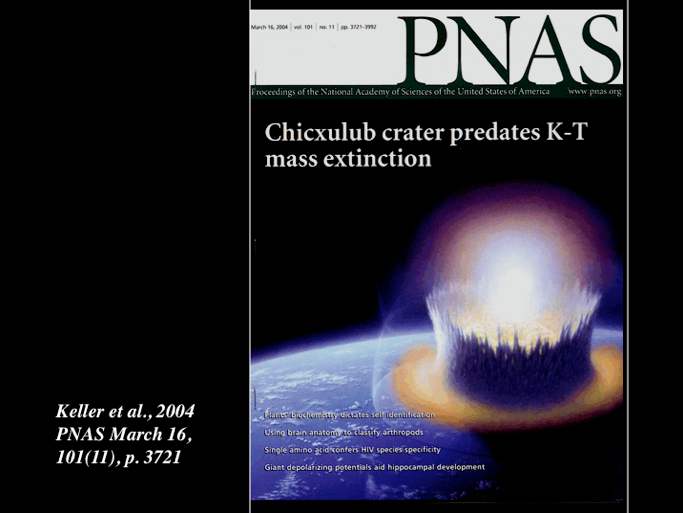
Figure 29. The Keller et al., 2004 study was published by PNAS.

